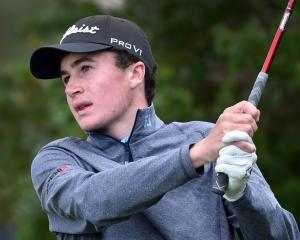
In the beginning
Charles Ritchie Howden. He was the man.
The "father of New Zealand golf" was born in Edinburgh and was 23 when he came to Otago to work on sheep runs.
Howden loved a wee dram — well, he was Scottish — and founded the New Zealand Distillery Company, which made him a load of money before teetotal lawmakers got in the way.
He was a keen golfer — well, he was Scottish — and he was the driving force behind the formation of the Dunedin Golf Club in September 1871, when he became the first club captain.
Annual subscriptions were set at a guinea.
The only problem was nobody had any clubs or balls, so there were some urgent telegrams to clubs and companies in England to get some "mashies" and "niblicks" on the next steam ship.

Where things get a little cloudy — and some other clubs have occasionally used this to dare suggest the Otago Golf Club is NOT the oldest in New Zealand (and the southern hemisphere) — is that the Dunedin club went into recess for a period in the 1880s.
It was reborn as the Otago Golf Club in 1892. Howden, who had been back in Scotland for a time, returned as captain and signed a deal to take over the trophies and rules of the Dunedin Golf Club.
The course
The Otago Golf Club played on a Roslyn-Kenmure course from 1892 to 1896 — it hosted the inaugural New Zealand Amateur there in 1893.
But golf did not have a lot of political power at the time, and the land owner was threatening to dig it up, so our man Howden and his mates had to find a new course.

Various tinkering and lease arrangements were put in place in the subsequent years. In 1911, the Otago club bought McGlashan’s estate to effectively complete the property on which the present course stands, and major layout work was done starting in 1923.
The course was reconfigured again in 1970 and has largely been kept in place with some bunker modifications and tree planting.
Balmacewen is 5917m, on the short side for a modern championship course, but its views and native bush and challenging slope rating and history-soaked clubhouse endear it to plenty.
The signature hole is No 11, The Glen, an unforgiving par-4 at the back of the course that demands you shoot safely on to the fairway or else.
The women

The Dunedin Ladies Golf Club was formed in 1892 — but, like the men, it quickly morphed into the Otago Ladies Golf Club.
The club, which interestingly was open to boys, also hosted the inaugural New Zealand Amateur in 1893, a rather significant year for women, and shifted from its original Roslyn base to Balmacewen with the blokes in 1896.
Both the Otago women’s and the men’s clubs co-existed for over a century until they formally amalgamated in 2009.

The greats
Balmacewen is not Augusta or St Andrews — but this is a course that has at various times been rated one of the best in the world, and it has attracted some spectacular players.
You might have heard of a bloke called Gene Sarazen, the American immortal who won seven majors and was the first to seal a career grand slam. Sarazen actually selected The Glen as one of the best 18 holes in the world.

"When Arnie drove The Glen" is the famous story of when Palmer played Kiwi hero Bob Charles at the Otago club in 1966 and absolutely crushed his drive off the 11th tee, driving the 370m green then two-putting.
Gary Player! Yes, the South African great has his name on the honours board at Balmacewen as he fired a hole in one at the par-4 Ridge hole.

And if that is not enough, South African wunderkind Bobby Locke won the New Zealand Open at Balmacewen in 1938, aged 20. Locke would later win four British Opens.
Hometown heroes

But there have also been plenty of local stars to emerge from the undulating fairways at Balmacewen.
It started with Otago Golf Club member James Somerville, who had not long arrived from Scotland when he won the inaugural New Zealand Amateur at the club in 1893.
Hugh MacNeil and Arthur Fisher were interesting characters. Both won the New Zealand Amateur, and both played first-class cricket for Otago. Fisher still holds the Otago record of nine for 50 in an innings.
A lovely story came in 1933 when the Otago Golf Club produced both the national amateur champions.
BV "Pip" Wright won the men’s title at Titirangi, and Oliver Hollis (nee Kay) claimed the women’s title at Whanganui.
Ben Gallie was another New Zealand Amateur champion, winning on the 37th hole in 2001.

Greg Turner’s record speaks for itself. The two-time New Zealand Open champion later turned into a highly respected course designer.
Mahal Pearce delivered one of the great stories for the club when he came from (seemingly) nowhere to win the New Zealand Open in 2003.
Hollis is the club’s greatest female player — she was also a member at St Clair — while the huge influence in the modern women’s era at Balmacewen is Shelley Duncan, who represented New Zealand and played at the US Open, and is now the Otago Golf Club general manager.
The opens and amateurs

The club has also hosted the New Zealand Amateur 12 times — in 1893, 1896, 1900, 1904, 1908, 1913, 1928, 1938, 1948, 1953, 1992 and this week.













